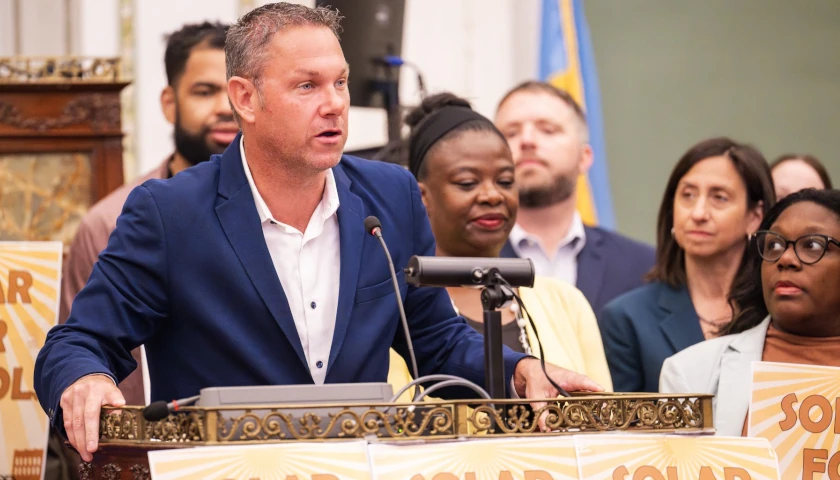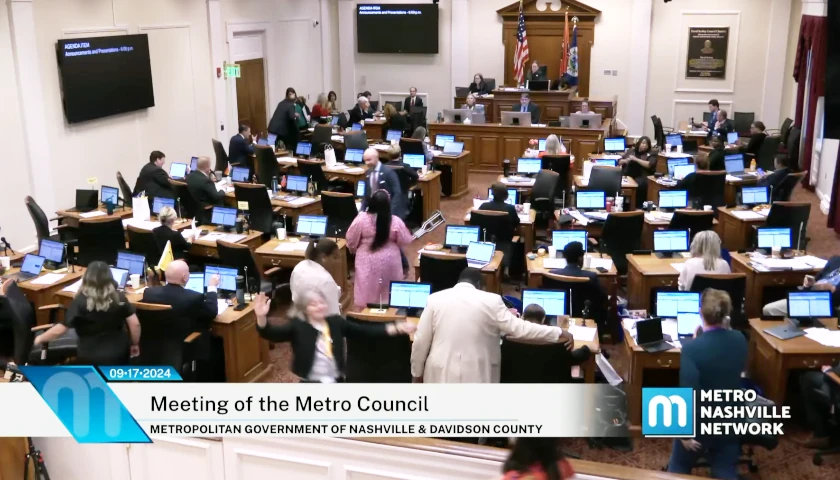by James D. Agresti
Many people blame racism for the grave problems that afflict a greater portion of black people than whites, including substandard educational outcomes, poverty, violence, incarceration, and poor health. However, comprehensive facts reveal no association between racism and these afflictions – much less evidence of causation. In fact, many of these problems grew worse with declining racism and rising levels of political and social power held by minorities.
In contrast, there are very strong associations between these scourges and leftist public policies and mindsets. Because association does not prove causation, these connections cannot prove that leftism caused these outcomes, but they open the door to this possibility. Other facts reinforce this prospect because minorities who are distanced from leftist environments and ideals don’t suffer like those who are surrounded by them.
Remarkably, the facts that reveal these correlations sometimes come from the research of progressive scholars who buried the information deep within their publications.
Junk Science & Anecdotes
Before examining the data, it is vital to emphasize one of the most important and neglected facts of public policy: association does not prove causation. This is commonly taught in high school math, but it is routinely ignored by Ph.D. scholars, journalists, and commentators. In the words of an academic textbook about analyzing data:
Association is not the same as causation. This issue is a persistent problem in empirical analysis in the social sciences. Often the investigator will plot two variables and use the tight relationship obtained to draw absolutely ridiculous or completely erroneous conclusions. Because we so often confuse association and causation, it is extremely easy to be convinced that a tight relationship between two variables means that one is causing the other. This is simply not true.
The reason why it is not true is because other factors or reverse causation may be at play. For example, violence and poverty are often associated with one another, but does poverty cause violence, or does violence cause poverty? Or do they feed upon each other in a vicious cycle? Or are they both caused by another factor or a combination of other factors?
Without a tightly controlled experiment, the answers to such questions are often difficult or impossible to determine with certainty. As one scholar cleverly explained, “If you want to pull a causal rabbit out of the hat, you have to put the rabbit into the hat.” A failure to understand or reveal this is a common feature of junk science and political propaganda.
Even more misleading is the widespread practice of using anecdotes to make sweeping generalizations. Given that the U.S. is the third-most populous nation in the world and has more than 330 million people, there is no shortage of events to serve the agendas of people who use isolated incidents to weave a narrative that doesn’t reflect the big picture.
A typical example is the media’s fixation on just a few of the 16,000 murders that occur every year in the United States. The editorial board of the New York Times recently accused police of being systemically racist and violent by naming 12 “black Americans brutalized or killed by law enforcement” since 1999. Yet, these cases amount to just one out of every 27,000 murders committed over this 21-year period and less than one out every million police officers who served in each of these years.
Such rhetoric exploits the statistical fact that anecdotes can be highly deceitful and the psychological fact that people are easily misled by them because it’s easier to grasp stories than data. It is also a hallmark tactic of racists and demagogues who demonize broad groups of people based on the actions of a few.
All that said, observational data and associations are at the core of social science, and they can be suggestive of causes and effects to a certain degree. Though such evidence can rarely reach the threshold of 100% confidence, it can approach that if all other reasonable explanations are ruled out—as is the case with some of the issues below.
Education
Across a broad range of measures, the average educational outcomes of black and Hispanic students are far below that of whites and Asians. This is the case even among serious students who take the ACT college readiness exam. In 2019, the following portions of high school seniors who took the ACT exam met its college readiness benchmarks in at least three of the four subjects it covers:
- 62% of Asians
- 47% of whites
- 23% of Hispanics
- 11% of African Americans
A common explanation for such disparities is that schools with lots of minority students receive less funding per student than schools with high proportions of white students. This allegation has been made by Elizabeth Warren, the New York Times, the Associated Press, Education Week, NPR, and Bernie Sanders.
Their claims, however, are based on studies that exclude federal education funding, which flows overwhelmingly to schools in low-income areas. Yet, the authors of these studies bury that fact in their publications, thus misleading people who don’t carefully read them and giving cover to those who deliberately mispresent them.
In contrast, wide-ranging studies that include all sources of funding have found that for the past 50 years, school districts with large portions of minority students spend about the same amount per student as districts with small portions of minorities. This includes analyses conducted by the U.S. Department of Education (1996), Ph.D. economist Derek Neal (2006), the left-leaning Urban Institute (2008), the conservative Heritage Foundation (2011), the Brookings Institution (2017), and the academic journal Education Next (2017).
Contrary to racist views that minority children are intellectually inferior or that their parents are to blame for their poor performance, empirical facts show that students of all races and backgrounds can and do excel – if they have competent schooling. A prime example is Public School 172 in Brooklyn, New York, which in 2009 had:
- a mainly Hispanic population.
- one-third of the students not fluent in English and no bilingual classes.
- 80% of the students poor enough to qualify for free lunch.
- lower spending per student than the New York City average.
- the highest average math score of all fourth graders in New York City, with 99% of the students scoring “advanced.”
- the top-dozen English scores of all fourth graders in New York City, with 99% of students passing.
Collectively, these facts reveal that racial disparities in education are not associated with funding and are not predestined by biology or parenting. There is, however, a very strong association between poor educational outcomes and leftism, a core ideology of the Democratic Party.
Modern U.S. leftism is characterized by a variety of doctrines like socialism, intersectionality, radical environmentalism, sexual licentiousness, and negative views of the police, U.S. military, and free speech. These are treated as conventional wisdom and righteous causes in institutions that are dominated by Democrats.
Public K–12 schools are mainly run by local governments, and the Democratic Party has controlled the local governments of minority communities for decades. Although white voters favor Republicans over Democrats by an average margin of 1.2 to 1, Hispanic voters favor Democrats over Republicans by 2.2 to 1, and black voters favor Democrats over Republicans by a staggering margin of 9.2 to 1:
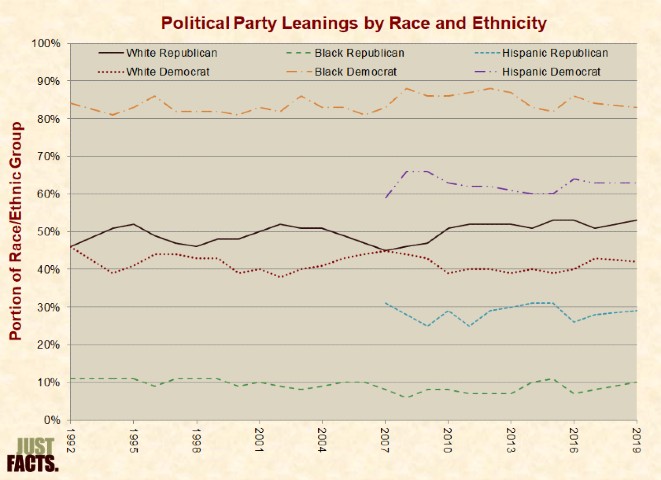
This concentration of political power gives leftism vast sway over schools attended by black children, and such policies may contribute to poor educational outcomes. These include but are not limited to:
- less time being devoted to teaching practical skills because curriculums are packed with progressive priorities like critical race theory, social justice, environmentalism, and sexual instruction.
- instilling a victim mentality in students, which is a defining element of intersectionality and is associated with weak self-control and less ability to persist in challenging tasks.
- lax disciplinary standards that allow untruly students to disrupt the learning of the entire classroom.
- placing the demands of teachers’ unions – which are a major source of funding to Democrats – over the desires of parents and the welfare of students.
Another remarkable association that comports with the theory that leftism harms students of color is that their educational outcomes are much worse in progressive cities than conservative ones. This fact comes from a 2020 study by the education nonprofit Brightbeam, where Barack Obama’s Secretary of Education, Arne Duncan, sits on the board. The authors of this study examined racial education gaps in the 12 most-progressive and 12 most-conservative U.S. cities and found these stunning results:
- Overall, students in progressive and conservative cities “have roughly the same proficiency rates,” but “students in America’s most progressive cities face greater racial inequity in achievement and graduation rates than students living in the nation’s most conservative cities.”
- “We tried to explain it away, but we couldn’t. There are many factors that contribute to student success, and while we could not control for all of them we did our best to consider the best explanations,” including “city size, racial demographics, spending, poverty or income inequality.”
- “But controlling for these factors did not erase the correlation between a city’s progressivism and the sizable racialized gaps in educational outcomes.”
- “Our research shows that there are U.S. cities where little to no gaps exist. Those cities happen to be conservative.”
- Per-student “spending is actually much higher in most progressive cities with large gaps than in conservative cities with small or negligible gaps, so that doesn’t explain” why minorities in progressive cities fare so poorly.
- The results are “stable no matter how we looked at the data. The biggest predictor for larger educational gaps was whether or not the city has a progressive population.”
Poverty & Income
Leftists typically blame systemic racism for the poor economic conditions of many minorities, but as with education, these problems actually coincide with leftist policies and mindsets.
In the U.S., 36% of children who live in homes led by single females are in poverty, a figure that falls to only 6% for children who live with married parents. Likewise, the poverty rate for black married couples is 9%, which is below the 13% rate for Asian divorced families and less than half of the 24% rate for white separated families.
Well beyond poverty, the median reported household cash income for black married couples is $88,000 per year. This doesn’t include capital gains and a host of non-cash benefits that amount to tens of thousands of dollars per year.
Despite the clear relationship between income and marriage, progressives have promoted premarital sex, cohabitation, and unwed child-bearing. They have also enacted and expanded an array of welfare programs that financially incentivize these actions. With this, the portion of unmarried or nonfamily households in the U.S. has risen from 22% in 1947 to 52% in 2019:
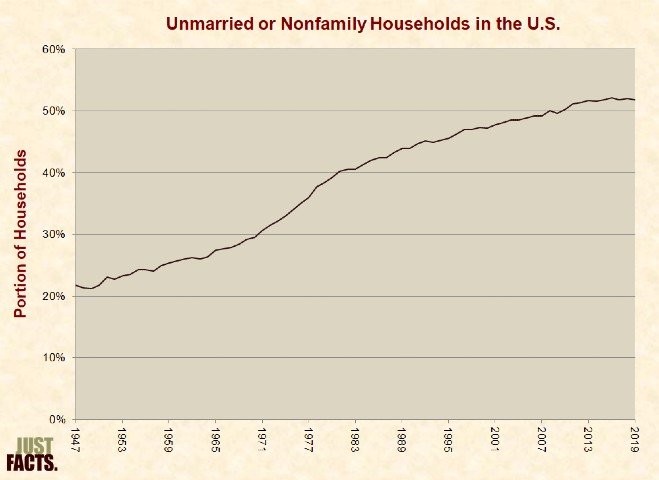
Non-married households are much more common in Democrat-controlled minority communities – but progressives try to explain away these realities with talking points that are at odds with the facts of the matter.
For example, Jeff Spross, an economics and business correspondent for The Week, has alleged that the “primary” reason for the collapse of marriage in the U.S. is the “demise of good middle-class jobs and economic security.” This claim conflicts with the fact that the average inflation-adjusted income of U.S. middle-income households grew by 32% from 1979 to 2016. And for the poorest 20% of households, this figure rose by 74%.
A rational and factually coherent explanation for the collapse of marriage is the spread of liberal views towards sex outside of marriage, divorce, and unwed child-bearing. Since Gallup began polling Americans on these issues in 2001, moral acceptance of sex between unmarried men and women rose from 53% to 72%, divorce from 59% to 77%, and having a baby out of wedlock from 45% to 66%. These changes took place in only the last 19 years, and much larger ones surely occurred during the sexual revolution that began in the 1940s and burgeoned in the 1960s to 1980s.
Moreover, liberals are 24 to 33 percentage points more likely to find those actions morally acceptable than conservatives. Ethics aside, the practical result of these actions is to spread workers’ wages over an increasing number of homes, thus reducing household incomes and deepening poverty.
Progressives also blame racism from decades in the past for economic disparities in the present, but these explanations don’t hold water either.
For instance, Jared Bernstein, the chief economist for Joe Biden during his vice presidency, claims that “for as far back as we have the data, the black unemployment rate has been twice that of the white rate….” This, he says, is an example of the “systemic racial injustice embedded in the economy.”
Yet, data cited by Democratic President Lyndon B. Johnson in a 1965 speech directly refutes that storyline:
- “Thirty-five years ago the rate of unemployment for Negroes and whites was about the same. Tonight the Negro rate is twice as high.”
- “In 1948 the 8 percent unemployment rate for Negro teenage boys was actually less than that of whites. By last year that rate had grown to 23 percent, as against 13 percent for whites unemployed.”
Notably, those racial disparities emerged and proliferated as the Democratic Party gained a foothold in black communities. Per the textbook AP U.S. History: All Access: “Virtually all blacks who could vote were registered as Republicans from 1865 until the 1930s.” That began changing in the 1930s because while Southern Democrats effectively blocked blacks from voting in the south, Northern blacks began switching in large numbers to the Democratic Party because they supported the “New Deal” welfare programs of President Franklin Delano Roosevelt.
Furthermore, those same racial disparities and others worsened as racism declined dramatically. For instance, Gallup polls going back for more than half a century reveal that the portion of Americans willing to vote for a black president rose from 37% in 1958 to 95% by 1999:
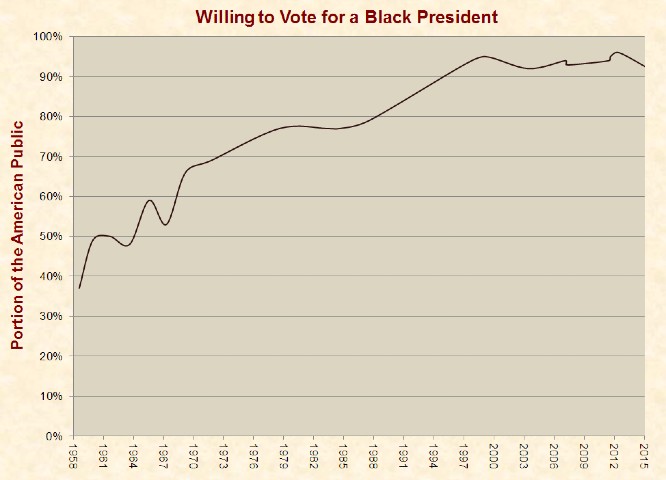
As explained by Gallup, 95% is “essentially universal willingness to state to an interviewer that the race of a candidate for president would make no difference.” In fact, the portion of non-white voters willing to vote for a black president is essentially the same – 98% in 2012 and 93% in 2015. These figures are all within the surveys’ margins of error.
Another canard spread by progressives is that racial discrimination is to blame for the 18% wage gap between college-educated blacks and whites. In truth, this gap is also traceable to leftism, specifically the weak educational foundations that black students acquire in Democrat-run schools.
In 2003, the American Institutes for Research assessed the literacy skills of a random sample of graduating college students. This study found that among graduating students at 4-year colleges:
- 45% of whites and 17% of blacks were proficient in document literacy, which is the ability to “search, comprehend, and use information from noncontinuous texts.”
- 40% of whites and 5% of blacks were proficient in quantitative literacy, which is the ability to “identify and perform computations … using numbers embedded in printed materials.”
Likewise, a 2016 study by Georgetown University’s Center on Education and the Workforce found that black college students:
- are “highly concentrated in lower-paying majors” like administrative services and social work.
- are much less likely than other students to major in science, technology, engineering, and math, even though African Americans in these fields “can earn as much as 50 percent more than African Americans who earned a bachelor’s degree in art or psychology and social work.”
Those racial deficits in practical skills reduce the earning power of black people and limit their career choices.
Wealth
According to Joe Biden and many other Democrats and activists, systemic racism is also to blame for the wealth gap between blacks and whites. Once again, the facts do not support this storyline and instead implicate leftism.
One of the mainstays of their argument is that mortgage companies discriminate against people of color by charging them higher rates, as reported by CBS, NBC, and the New York Times. That claim was refuted by a 2019 study of mortgage costs by Federal Reserve Board economists Neil Bhutta and Aurel Hizmo. Based on comprehensive data, they found that whites, blacks, Hispanics, and Asians with similar credit histories all pay “virtually identical” overall mortgage costs.
As Bhutta and Hizmo detail, earlier studies found racial disparities only because they ignored upfront mortgage fees, which “can add up to thousands of dollars.” This is important because black and Hispanic borrowers “tend to choose slightly higher interest rates in return for lower upfront costs. Hence, studies that fail to account for these fees generate “misleading results about the presence of discrimination.”
Another progressive contention is that past discrimination explains current racial wealth gaps. They say these disparities mainly stem from racist practices decades ago that prevented black people from buying homes, thus leaving them unable to pass this source of wealth on to their children.
Yet, inheritances account for only 11% of the median wealth gap between blacks and whites. Thus, even under the implausible assumption that racial differences in inheritances are entirely due to discrimination and not from low incomes or any other factor, this would explain only a tiny portion of the wealth gap.
Furthermore, today’s black/white home ownership gap of 30 percentage points is actually greater than the 27-point gap in 1960 when it was “legal to refuse to sell someone a home because of the color of their skin.” In other words, the racial homeownership gap has stayed about level for more than half a century despite tremendous progress in civil rights and great reductions in racism.
All of these facts indicate that current and past discrimination are not associated with the racial wealth gap. So what is? Low incomes and poor money management that stem from leftist outlooks and policies.
In 1999, Freddie Mac – a government-sponsored enterprise that is tasked to help low- and moderate-income families obtain mortgages – published a study that drew the ire of Democrats because it measured the rates of “bad credit” among blacks and whites. As defined by the study, people with bad credit were those over the past two years who were more than 30 days late paying two bills, more than 90 days late paying one bill, or had a bankruptcy, lien, or judgment. The data, which was based on a scientific sample of 80,000 people, showed that upper-middle income blacks had a higher rate of bad credit than low-income Asians and whites. For example:
- 20% of Asians who earned less than $25,000 per year had bad credit.
- 27% of whites who earned less than $25,000 per year had bad credit.
- 34% of blacks who earned $65,000 to $75,000 per year had bad credit.
The study did not determine the reasons for these disparities, but one of the authors’ theories was that “people who believe they control their lives tend to budget better and save more.” This accords with a 2015 paper in the Proceedings of the National Academy of Sciences, which studied how political beliefs affect people’s self-discipline and found that:
- “conservatives more strongly embrace the belief that they are responsible for their actions,” and this mindset is “intricately linked to basic motor processes critical to effective self-control.”
- “liberals tend to attribute” people’s circumstances to “external factors” like “systemic or sociocultural forces,” and this “decreases activation in brain regions associated with intentional – and arguably goal-directed – action.”
A similar way in which leftism discourages savings and wealth accumulation is via social programs. As detailed in 2016 working paper published by the European Central Bank:
- “As the state organizes and offers more public insurance, there is less need for relatively poor households to hold precautionary savings, and more income might be used for consumption purposes.”
- Social “services provided by the state are substitutes for private wealth accumulation.”
- European nations with greater levels of “welfare state spending” have higher levels of “wealth inequality.”
Health
In the U.S., black people live an average of 3.6 years less than white people. Media outlets like USA Today and Reuters deem this to be the result of systemic racism, but their logic is overturned by the fact that Hispanics in the U.S. live an average of 3.3 years longer than non-Hispanic whites.
The same applies to the oft-cited statistic that black women are about three times more likely to die from pregnancy-related complications than white women. While reporting this, media outlets routinely blame racism and fail to mention or bury the fact that Hispanic women about are 9% less likely to die from pregnancy-related complications than white women.
Once again, the facts show that these disparities are not associated with racism.
Based on four different methods that produced roughly the same results, a 2019 paper in the Annals of Family Medicine found that “social and behavioral factors” – not “deficiencies in health care access or delivery” – are the main drivers of life expectancy disparities in the United States.
Leftists bristle at such facts, thereby impeding the solution to the problem. When Dr. Jerome Adams, the U.S. Surgeon General, stated that “communities of color” who are being heavily impacted by Covid-19 should “avoid alcohol, tobacco, and drugs,” a reporter replied: “There’s some people online that are already offended by … the idea that you’re saying behaviors might be leading to these high death rates.”
Among other things, Adams explained that people “are not helpless” and “everybody needs to do everything they can to be as healthy as possible at this critical time.” This helpful, factual advice is in tension with the leftist doctrine of intersectionality and the victim mentality that it nurtures. This, in turn, reduces the willpower needed to make positive changes.
Violence & Incarceration
Among all of the afflictions that disproportionately impact people of color, violence may be the worst. In 2018, blacks comprised 13% of the U.S. population but roughly 53% of the 16,000 murder victims. Here again, the facts reveal a strong association between leftism and these tragedies.
For more than half a century while progressive views about sex and parenting proliferated, so has the portion of children who grow up in single-parent households. This is associated with a wide range of social ills, including emotional problems, drug abuse, and criminal behavior. The same applies in progressive nations like Sweden, where the children of single parents have significantly greater risks of psychiatric disease, addiction, and death.
Compounding that, leftists often argue that the criminal justice system is too hard on lawbreakers in general and minorities in particular. However, a host of facts show that minorities – the vast majority of whom are law-abiding – suffer greatly from under-incarceration of violent criminals in their neighborhoods. This has grown worse with reductions in racism and the growth of progressivism. Here are some poignant examples of how this has played out:
- The portion of murders in the U.S. that resulted in a suspect being identified and acted upon by the criminal justice system declined from 92% in 1960 to 62% in 2018.
- In the Democrat-dominated city of:
- Chicago, the portion of murders that resulted in a suspect being identified and acted upon by the criminal justice system declined from 96% in 1964 to 45% in 2018.
- Baltimore, the portion of murders that resulted in a suspect being identified and acted upon by the criminal justice system was 32% in 2019.
- In 2015 when Baltimore experienced the highest per-capita murder rate in its history, the average homicide suspect had been previously arrested more than nine times.
- For every 15 aggravated assaults, robberies, sexual assaults, rapes, and murders committed in the United States in 2006, approximately one person was sentenced to prison for committing such a crime.
- From 1965 to 2018, 314,550 murders were committed in the U.S. that were still unsolved as of 2018.
When murders and other violent crimes remain unsolved or unpunished:
- the perpetrators remain free to commit more carnage.
- potential criminals are less deterred because they become less concerned about being caught.
- citizens’ fears of crime and retribution for reporting crime are increased.
With that, progressive portrayals of police as violent racists make witnesses less likely to cooperate in putting the perpetrators behind bars. Leftists argue that that their views of police are justified, but the fact is that police are 42% less likely to use lethal force when arresting black people than when arresting whites. This fact is from a 2016 study of arrest data by the left-leaning Center for Policing Equity. However, the authors of this study buried this data on the 19th page of a 29-page report and never mentioned it in their summary or conclusion.
Contrary to media storylines that exploit half-truths, incomplete data, and outright falsehoods, black and white people are typically arrested, prosecuted, and sentenced at rates that accord with the frequency and severity of their criminality. A notable exception to this rule is murder because blacks are much more likely than whites to get away with this crime. This harms black communities because the killers remain free to commit more carnage.
Furthermore, most law enforcement occurs at the local level, and the governments of minority neighborhoods are typically dominated by Democrats.
Conclusion
The challenges that face Americans in the realms of education, poverty, income, wealth, health, violence, and incarceration are more frequent and severe for people of color than whites, but the reasons for this are difficult to pin down because of the empirical fact that association does not prove causation.
However, comprehensive facts show that racism – which is the common progressive explanation for these problems – is not associated with them. Instead, these problems are strongly correlated across time and place with leftism, a philosophy that embraces intersectionality, sexual licentiousness, negative views of police, and socialism.
– – –
James D. Agresti is the president of Just Facts, a think tank dedicated to publishing rigorously documented facts about public policy issues.
Photo “Socialism” by ep_jhu CC BY 2.0.



